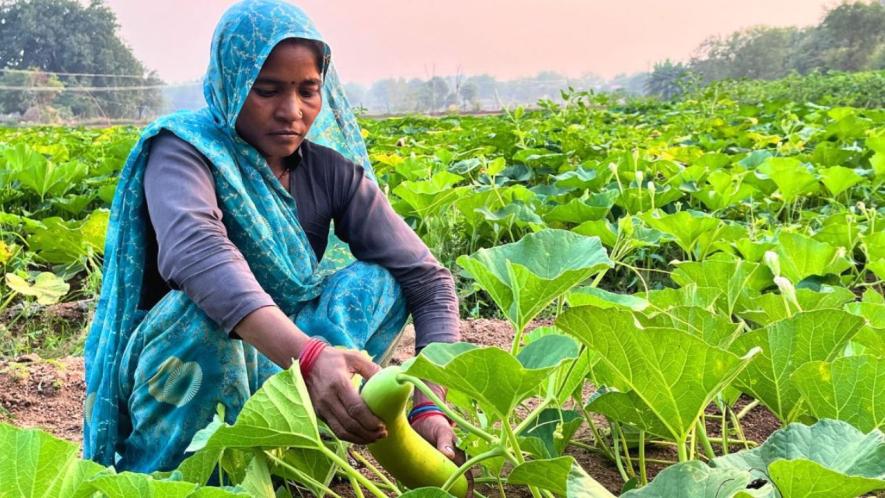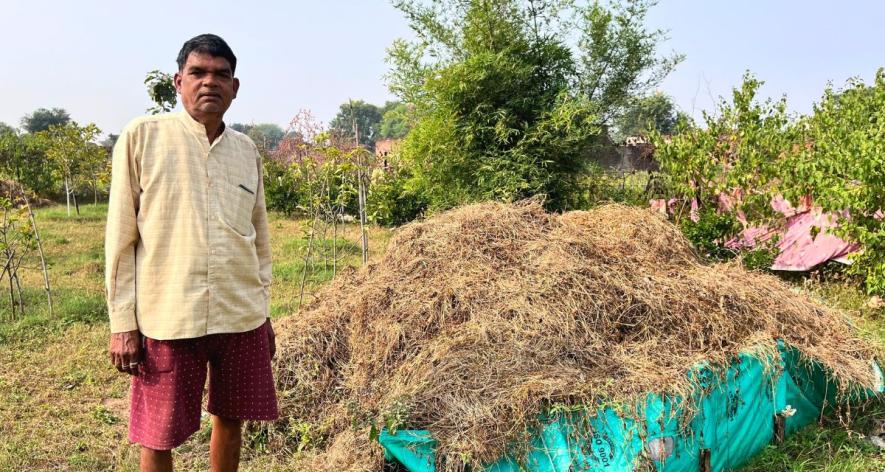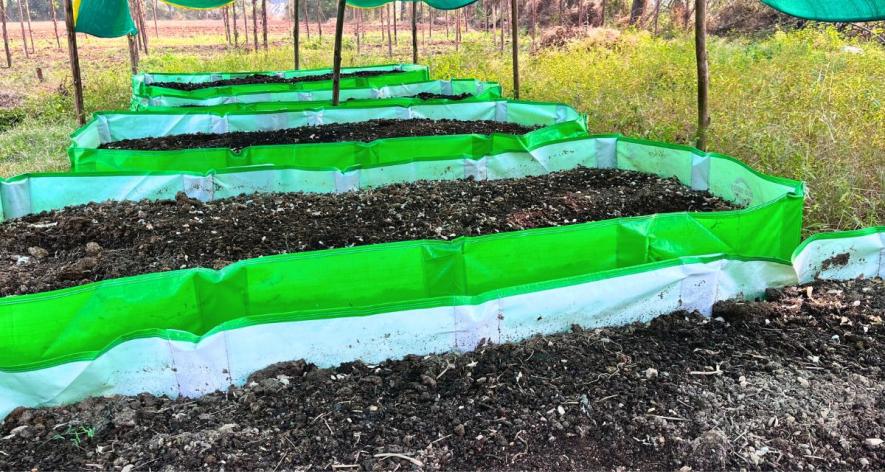Grow Organic, Sell Non-Organic: The Predicament of Bundelkhand's Marginal Farmers

Anita plucks bottle Gourd from her nutrition garden in Lahar Thakurpura village in Jhansi district of Bundelkhand (Photo - Sneha Richhariya, 101Reporters).
Jhansi, Uttar Pradesh: In the semi-arid Bundelkhand region spread across Uttar Pradesh and Madhya Pradesh, climate vulnerability is a pressing reality. With dwindling forest resources, the region is susceptible to desertification — something that does not bode well for agriculture here.
According to the Bundelkhand Drought, a report released by the National Institute of Disaster Management (except for Sagar and Jhansi districts), approximately 60% of Bundelkhand's population depends on agriculture, either as cultivators or labourers. Water resources were limited in the region, while recurrent and consecutive droughts made rain-fed agriculture uncertain. However, over the years, schemes such as Khet Talab Yojana and construction of dams improved water availability, but not without a catch.
In recent decades, there has been a shift towards cash crops from millet cultivation due to increased water availability and other factors. A 2021 study published in the Indian Journal of Extension Education confirms the decline by analysing data regarding area, production and productivity of major millets between 2000 and 2020 in Bundelkhand region of Uttar Pradesh.
“This region was historically known for its largely chemical-free cultivation. Crops such as millets, oilseeds and pulses, which require minimal fertilisers, dominated the landscape. Today, minor millets such as sama and kodo have mostly disappeared, surviving only in isolated pockets where irrigation facilities remain limited,” Dr SS Singh, Director (Extension Education), Rani Lakshmi Bai Central Agricultural University (RLBCAU), Jhansi, tells 101Reporters.
“Rising food demand and improved irrigation have shifted crop patterns and increased fertiliser use, causing a decline in organic and natural farming practices,” Singh adds.
At the same time, Bundelkhand's fragile soil makes it unsuitable for high-intensity cropping. Promoting organic and natural farming is the desired path to preserve the region’s ecosystem.
Multiple challenges
Aatmaram Rajput (62) from Badaura in Jhansi's Babina block is a beneficiary of Paramparagat Krishi Vikas Yojana (PKVY). While the scheme officially lists his wife Ranjana Rajput as beneficiary, Aatmaram has been actively involved in implementing the organic practices promoted under the programme.
“Under PKVY, I cultivate millets and vegetables on six acres. Last year's kodo millet harvest is still lying with me because there are no buyers,” Aatmaram shares. For cultivation, seeds were given under the scheme for free and farmers trained in preparing organic manure.
The situation is no better for vegetables. “Organic vegetables are priced the same as chemically grown ones... There is a lack of market incentives for organic produce,” he points out.
PKVY was launched nine years ago with the main objective to encourage organic farming among small and marginal farmers. However, the problem lies with a lack of designated markets and certification issues, which leave farmers with no option but to sell their produce in the markets where non-organic products are sold.
Agriculture Processed Food and Export Development Authority (APEDA) functioning under the Ministry of Commerce and Industry regulates organic farming certification in the country through the National Programme for Organic Production (NPOP), which sets standards for organic farming, outlines procedures for accreditation certification bodies and manages the use of the India Organic logo.
For certification, farmers need to apply in the required format, pay a fee and undergo a field verification process. Mostly large players have accessed it as the certification is costly. Put simply, a farmer has to spend anywhere between Rs 12,000 and 20,000 per acre per annum for the certification.
According to Delhi-based non-profit Centre for Science and Environment, the challenges that PKVY face include inadequate training, insufficient funding and the failure to establish a strong domestic market for organic products.
“The certification process is very tedious. But it is important because otherwise the consumer will not know what is organic and what is not,” says Dr Yogeshwar Singh, Professor, Department of Agronomy and Agrometeorology, RLBCAU.
"The process requires multiple visits from officials, and farmers must ensure that not only their farms but also the neighbouring farms are chemical-free as any chemical runoff from adjacent lands could contaminate their soil," Dr Yogeshwar explains. Moreover, certification alone cannot solve the market issue. There is a need for demand generation.
For the farmers of Jhansi, the nearest certification centre is 462 km away, in Ghaziabad. Hence, most farmers do not show interest. "Who will travel so far for this spending their own money," asks Mansingh Ahirwar (62), a farmer from Khajuraha Bujurg in Jhansi district.

Mansingh Ahirwar poses with his vermicompost unit in Khajuraha Bujurg village in Jhansi (Photo - Sneha Richhariya, 101Reporters).
Dr Yogeshwar suggests allotting a blockchain number for a group of farmers in a particular region. This will make it easier to grant organic certifications also. Moreover, the consumers will know from where the produce is coming. “The urban consumers are keen on organic products, but they face difficulties in finding reliable suppliers. Blockchain can solve this issue,” he hopes.
“In the last three years, 80 clusters have been formed in Jhansi under PKVY by involving around 3,900 farmers. Each cluster deals with 50 hectares,” Anil Kumar Solanki, Senior Training Assistant, Krishi Vigyan Kendra, Jhansi, tells 101Reporters. “We are training farmers and offering assistance. Nevertheless, their products find it difficult to compete with the chemically grown produce in the market. Farmers ask us where is the market for organic,” he adds.
Yet, there are examples of organic farmers in the region making a profit when equipped with the right knowledge.
Happy faces
“Ek din mein 6,000 rupay!” Pukkhan Rajput (56) screams with joy, as the women in the neighbourhood sit in a circle, discussing the day’s sale of vegetables worth Rs 6,000. Pukkhan was selected to grow a poshan vatika (nutrition garden) under the Women’s Livelihood Promotion Initiative of non-profit ActionAid India, to create sustainable livelihood opportunities by training rural women in organic and natural farming practices.
Pukkhan and her husband used to grow wheat and groundnut on their distant two-acre land at Lahar Thakurpura in Jhansi district. To make ends meet, she also took up daily wage labour at construction sites in Ghaziabad and Delhi.
Life took a sharp turn during the COVID-19 lockdown when she was forced to return home. Their savings began to dwindle and that was when Pukkhan decided to secure food for her family by joining a women’s collective in 2022.
About 3,000 women entrepreneurs across 40 villages in Jhansi, Mahoba and Lalitpur districts are part of this collective that runs the programme of ActionAid India.
“I started cultivating vegetables on my husband’s ancestral land, which was lying vacant," says Pukkhan.
Pukkhan was trained by ActionAid to grow organic vegetables, prepare manure from cow dung and practice multi-cropping. On one acre, she planted a variety of crops, including brinjal, bottle gourd, beetroot, tomatoes, beans, pumpkin, chillies, etc. She also received 11 types of vegetable seeds and some farming tools, spray machines, drums to prepare fertilisers and material for farm fencing.
“After seeing my farm, other women in my neighbourhood evinced interest,” Pukkhan says. Her neighbours — Bharti Singh, Anita Rajput and Bichkunwar — went on to learn sustainable farming practices and have been growing nutrition gardens, producing seeds, doing multi-layer farming and vermicomposting.
“She sold vegetables worth Rs 1 lakh in just four months,” Bharti says, pointing towards Pukkhan. However, Pukkhan could gain profit because she managed to grow vegetables in large quantities with the right guidance, and not because her produce was organic. In fact, at present, both chemically grown and organic vegetables are sold for the same price in the same markets.
ActionAid claims to be making an effort to ensure a stable market for organic products, but also admits that they are competing with big FMCGs, while the market is also flooded with cheap alternatives in general.
Mukesh Kumar, district coordinator, ActionAid India, says their intervention is very targeted. “We initially offered several resources to farmers, including seeds, organic fertilisers, bio-pesticides, fencing material and training on sustainable farming techniques. Without this support, agroecological practices are tough to adopt," he says.
Some non-profits are working to address parts of the problem. Self-Reliant Initiatives through Joint Action (SRIJAN), which works in 11 districts of Madhya Pradesh and Uttar Pradesh, and Bundelkhand Initiative for Water, Agriculture and Livelihoods have set up bio-resource centres to improve production of organic manures and pest-repellants.
One such centre is managed by Balchandra Ahirwar, a farmer from Lidhaura Tal in Tikamgarh district of Bundelkhand. Here, cow urine is turned into organic nutrients, while farming tools such as power tillers and sprayers are available for hire. The cost of organic nutrients is about one-third of chemical fertilisers, and organic pest repellents are much cheaper than chemical pesticides. Balchandra has already sold inputs worth Rs 60,000, helping farmers save money while protecting the environment.

A vermicompost set-up by a Chhaya local farmer in Baidora village in Jhansi (Photo - Sneha Richhariya, 101Reporters).
Suhavna Rajput (33) from Khajuraha Bujurg is into machan, where multiple crops are grown simultaneously on the same land to maximise vertical space utilisation. "I use jeevamrit and beejamrit for seed treatment, which protects the crops from pests and diseases. It keeps the soil healthy also," she says.
After attending ActionAid's training, Anita Rajput (39) from the same village understood the importance of climate-friendly crops. "By using these flood and drought resistant varieties, we can ensure that our harvests are more reliable even in times of unpredictable weather," she says.
"We turn to livestock for income when excessive rainfall damages our crops," adds Devanti Ahirwar (28) from Khajuraha Bujurg, who follows the machan system and also keeps goats and chickens.
Agroecology the new hope
Climate modelling by the United Nations Institute for Training and Research predicts that temperatures in Bundelkhand could rise by 2 to 3.5°C by the end of this century.
To mitigate the impacts, efforts have been made to develop Bundelkhand into an agroecology zone. In June 2022, the agriculture department prepared a roadmap to promote chemical-free farming, following the directions of Uttar Pradesh Chief Minister Yogi Adityanath to promote organic farming in the state.
However, only regions with limited irrigation and non-remunerative crops offer potential for organic and natural farming, explains Dr Singh. “In areas where farmers are cultivating highly remunerative cash crops with chemical inputs and modern seeds, convincing farmers to adopt agroecology is challenging,” he says.
Dr Yogeshwar adds that it is not possible to popularise organic or natural farming in the entire Bundelkhand. “More than 20% of Bundelkhand’s farmlands are suitable for organic farming, but we should only push for market-led production… Essentially, this technique should be promoted in low productive zones only, strategically avoiding high productive zones as such a move would lead to steep fall in production and affect farmers’ income,” he explains.
He suggests that organic farming should be done in clusters, failing which it will be tough to establish their authenticity through blockchain. "It will only make sense when clusters growing organic produce are able to find and connect with reliable buyers," he adds.
(Sneha Richhariya is an Uttar Pradesh-based freelance journalist and a member of 101Reporters, a pan-India network of grassroots reporters.)
Get the latest reports & analysis with people's perspective on Protests, movements & deep analytical videos, discussions of the current affairs in your Telegram app. Subscribe to NewsClick's Telegram channel & get Real-Time updates on stories, as they get published on our website.
























